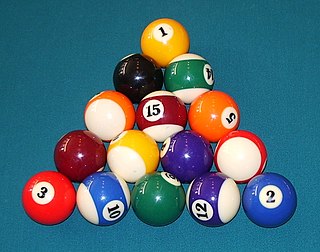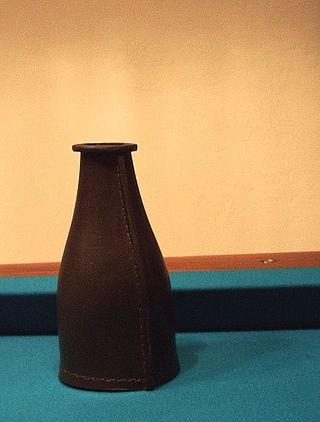
Cue sports are a wide variety of games of skill played with a cue, which is used to strike billiard balls and thereby cause them to move around a cloth-covered table bounded by elastic bumpers known as cushions. Cue sports are also collectively referred to as billiards, though this term has more specific connotations in some varieties of English.

Eight-ball is a discipline of pool played on a billiard table with six pockets, cue sticks, and sixteen billiard balls. The object balls include seven solid-colored balls numbered 1 through 7, seven striped balls numbered 9 through 15, and the black 8 ball. After the balls are scattered with a break shot, a player is assigned either the group of solid or striped balls once they have legally pocketed a ball from that group. The object of the game is to legally pocket the 8-ball in a "called" pocket, which can only be done after all of the balls from a player's assigned group have been cleared from the table.

Nine-ball is a discipline of the cue sport pool. The game's origins are traceable to the 1920s in the United States. It is played on a rectangular billiard table with pockets at each of the four corners and in the middle of each long side. Using a cue stick, players must strike the white cue ball to pocket nine colored billiard balls, hitting them in ascending numerical order. An individual game is won by the player pocketing the 9-ball. Matches are usually played as a race to a set number of racks, with the player who reaches the set number winning the match.

Straight pool, which is also called 14.1 continuous and 14.1 rack, is a cue sport in which two competing players attempt to pocket as many object balls as possible without playing a foul. The game was the primary version of pool played in professional competition until it was superseded by faster-playing games like nine-ball and eight-ball in the 1980s.
Golf billiards is a pocket billiards game usually played for money. Unlike the majority of such games, it allows more than two people to play without compromises or rule changes. The game borrows from the outdoor game of golf, which is historically related to the cue sports. It is usually played on 10-foot or 12-foot snooker tables as their size and structure are more appropriate. In 2006 the Billiard Congress of America commented it was more popular than snooker in the United States.
Cutthroat or cut-throat, also sometimes referred to as three-man-screw, is a typically three-player or team pocket billiards game, played on a pool table, with a full standard set of pool balls ; the game cannot be played with three or more players with an unnumbered reds-and-yellows ball set, as used in blackball. Each player is commonly assigned a set of five consecutively numbered object balls, though the number of balls will vary by number of players. The object of the game is to be the last player with at least one ball of their group remaining on the table.

Russian pyramid, also known as Russian billiards ', is a form of billiards played on a large billiard table with narrow pockets. It is played across Russia and several former Soviet/Eastern Bloc countries. In the West, the game is known as pyramid billiards, or simply pyramid.
Bank pool is a pool game that has as its most fundamental requirement that all scoring shots in the game must be made by banking a called ball off a cushion and into a called pocket.

A rack is a piece of equipment that is used to place billiard balls in their starting positions at the beginning of a pocket billiards game. Rack may also be used as a verb to describe the act of setting billiard balls in their starting positions, or as a noun to describe a set of balls that are in their starting positions.
The following is a glossary of traditional English-language terms used in the three overarching cue sports disciplines: carom billiards referring to the various carom games played on a billiard table without pockets; pool, which denotes a host of games played on a table with six pockets; and snooker, played on a large pocket table, and which has a sport culture unto itself distinct from pool. There are also games such as English billiards that include aspects of multiple disciplines.

Rotation, sometimes called rotation pool, 15-ball rotation, or 61, is a pool game, played with a pocketed billiards table, cue ball, and triangular rack of fifteen billiard balls, in which the lowest-numbered object ball on the table must be always struck by the cue ball first, to attempt to pocket numbered balls for points.

Three-ball is a folk game of pool played with any three standard pool object balls and cue ball. The game is frequently gambled upon. The goal is to pocket the three object balls in as few shots as possible. The game involves a somewhat more significant amount of luck than either nine-ball or eight-ball, because of the disproportionate value of pocketing balls on the break shot and increased difficulty of doing so. In some areas and subcultures, such as the Asian-American youth-dominated pool hall scene of San Francisco, California, three-ball is a popular local tournament game.
Cowboy pool is a hybrid pool game combining elements of English billiards through an intermediary game, with more standard pocket billiards characteristics. The game employs four balls, the cue ball and three others, numbered one, three, and five. A game of Cowboy pool is contested as a race to 101 points, with those points being awarded for a host of different shot types. Dating back to 1908, the game is a strictly amateur pastime.
Honolulu, also known as banks, kisses, and combinations or indirect, is a pocket billiards game. Players must pocket all shots in an indirect fashion to reach a set number of points. The game shares some similarities with other cue sports, played on tables and with balls used for pool, but differs with foul points being awarded for regular direct shots.

Five-pin billiards or simply five-pins or 5-pins, is today usually a carom billiards form of cue sport, though sometimes still played on a pocket table. In addition to the customary three balls of most carom games, it makes use of a set of five upright pins (skittles) arranged in a "+" pattern at the center of the table. The game is popular especially in Italy and Argentina, but also in some other parts of Latin America and Europe, with international, televised professional tournaments. It is sometimes referred to as Italian five-pins or Italian billiards, or as simply italiana. A variant of the game, goriziana or nine-pins, adds additional skittles to the formation. A related pocket game, with larger pins, is played in Scandinavia and is referred to in English as Danish pin billiards, with a Swedish variant that has some rules more similar to the Italian game.

Kelly pool is a pool game played on a standard pool table using a standard set of 16 pool balls. Gameplay involves players each drawing one of 16 numbered markers called peas or pills at random from a shake bottle, which assigns to them the correspondingly numbered pool ball, kept secret from their opponents, but which they must pocket to win the game. Kelly pool is a rotation game, which means that players must contact the lowest numbered object ball on each shot first until the opportunity to pocket their own is presented. If a player draws the number 16, this player is assigned the cue ball. In order to pocket the cue ball, the player must contact the lowest ball first and in the same shot, pocket the cue ball. However, the game is commonly played by removing the pea numbered 16 and playing with the basic 15 numbered balls and corresponding peas. Two rule variants are set forth under rules promulgated by the Billiard Congress of America (BCA). In the simpler form, the object of play starts and ends with the goal of pocketing one's secret ball. In the second, in addition to the goal of pocketing one's secret ball, points are scored in various ways. In the instance where pills are unavailable, a cloth may be used to cover the balls, which are then chosen blindly, recorded, and replaced for play.

Baseball pocket billiards or baseball pool is a pocket billiards (pool) that is loosely based on the game of baseball. The game is played on a standard pool table and suitable for multiple players. In baseball pocket billiards, many of the game's features are named after baseball terms, such as the 9 ball being named the "pitcher", the table's foot spot is "home plate", and each team or player is afforded "nine innings" to score as many "runs" as possible.

Bottle pool, also known as bottle-billiards and bottle pocket billiards, is a hybrid billiards game combining aspects of both carom billiards and pocket billiards. Played on a standard pool table, the game uses just two object balls, a cue ball, and a 6+3⁄4 inches (170 mm) tall, narrow-necked bottle called a shake bottle or tally bottle, traditionally made from leather, that is placed on the table and used as a target for caroms. Those unfamiliar with the game sometimes mistakenly use its name as a synonym for the very different game of kelly pool. Bottle pool has been described as combining "elements of billiards, straight pool and chess under a set of rules that lavishly rewards strategic shot making and punishes mistakes with Sisyphean point reversals."
Carom billiards and pool are two types of cue sports or billiards-family games, which as a general class are played with a stick called a cue which is used to strike billiard balls, moving them around a cloth-covered billiard table bounded by rubber cushions attached to the confining rails of the table.

Fifteen-ball pool, also known as sixty-one pool, is a pocket billiards game developed in America in the nineteenth century from pyramid pool. Created by members of the Bassford's Billiard & Chess Rooms in Manhattan during the late 1830s or 1840s, it is the ancestor to many American pool games.















